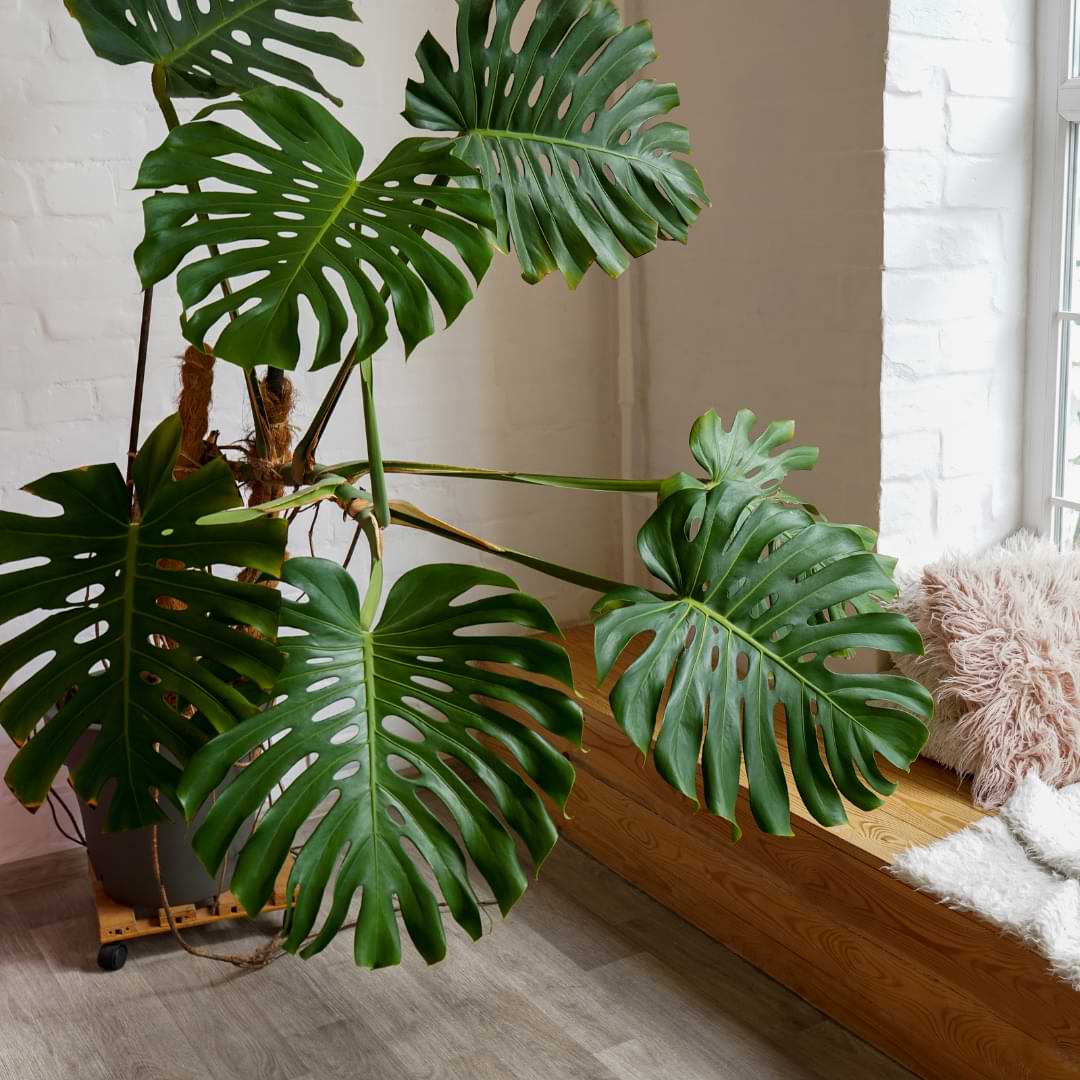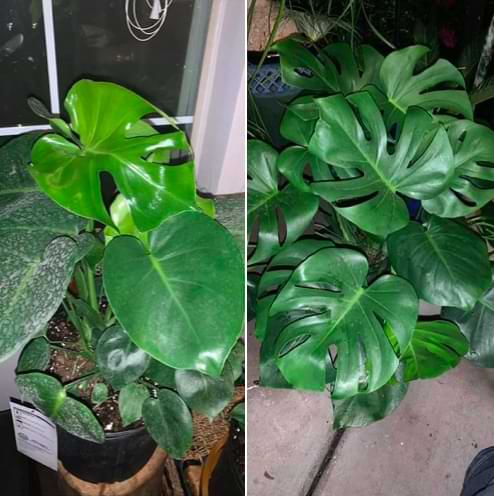Monstera plants are known for growing quite large indoors and outdoors. After all, they don’t have “monster” in their name for nothing!
But just how fast do monsteras grow indoors? How fast can you expect that new deliciosa you just picked up to start taking over your living room? Do all monstera varieties grow at the same rate, or reach the same height and width? And how can you get your monstera to grow faster?
We’ll answer all those questions in this article!
Table of Contents
Monstera Growth Rate
How Fast Do Monsteras Grow Indoors?
In general, healthy monstera plants will grow at a rate of about 1-2 feet per year with the right growth conditions, including sufficient light, water, and nutrients. The larger varieties like monstera deliciosa, monstera albo, etc., should grow around 2 feet each year, while the smaller varieties like monstera dubia will grow around a foot a year. (Though they can definitely grow faster! These vining plants can really reach with the right conditions!)
Most varieties will also put out a new leaf every 4-6 weeks or so during the growing season.
Keep in mind that most varieties will tend to grow horizontally rather than vertically, so this 1-2 feet of growth we’re referring to is more like length, because the plant will start to vine and spread.
We’ll talk more about staking and supporting monstera plants later in the article to encourage vertical growth rather than horizontal spreading.
How Fast Do Monsteras Grow in the Wild?
In the wild, monsteras tend to grow around 2 feet per year because conditions are usually more favorable in areas where they can actually grow outside. (This would be USDA Hardiness Zones 10-12.) They also have more room outdoors!
Outside, larger monstera species can climb up to 60 or 70 feet high while smaller varieties may only reach 10 to 15 feet tall.

Photo Credit: Jennifer Gonzalez a member of our Monstera Plant Community
Monstera Growth Through the Seasons
The typical growth season for monsteras is spring through fall. Inside, monsteras may follow the same growth patterns or grow in spurts year-round, since they may not experience actual seasons thanks to indoor climate control and artificial lighting.
How to Make Monsteras Grow Faster
So how do you make your monstera plant grow faster indoors? Here are the conditions you need to take into consideration to get a happy, rapidly growing monstera!
Optimum Light
Light is one of the most important factors in a monstera’s growth rate. After all, monsteras make energy from sunlight through the process of photosynthesis, and it takes lots of energy to grow!
Monsteras thrive with lots of bright, indirect sunlight similar to what they’d receive under the rainforest canopy in their native habitat.
An east-facing window is the perfect place for your monstera, because it can get a few hours of gentle morning light and then plenty of bright but indirect light the rest of the day.
A south- or west-facing window can also work, but you might need to filter the harsh sunlight with a sheer curtain or place your plant far enough from the window that the direct midday and afternoon sun won’t fall directly on the leaves. You don’t want a bunch of scorched leaves, after all!
A north-facing window might not provide enough light to keep your monstera healthy or give it the energy it needs to grow, so if this is your only option, you may want to consider using a grow light to provide more light. We love these full-spectrum grow bulbs because you can simply screw them into regular light fixtures. Easy!
Soil Moisture
Consistently moist—but not wet or soggy—soil is important for a monstera’s health and growth.
Make sure to pot your plant in a potting mix that drains well but also retains a little moisture rather than rapidly drying out. Indoor potting mix with a few handfuls of perlite mixed in can do the trick. For a DIY option, we also love this recipe from Kaylee Ellen on YouTube.
If you want the perfect monstera potting mix that’s ready to go right out of the bag, we recommend our Premium Monstera Potting Soil because it has the perfect balance of drainage and water retention, and also the perfect pH for monsteras while packing a nutritional punch!
And while we’re talking about drainage, your pot has drainage holes, right? Good. This is crucial for maintaining moist (but not soggy) soil.
Now for the other part of the soil moisture puzzle: watering.
As a general guideline, you’ll want to water your monstera when the top 2-3 inches of soil feel dry to the touch. You can test this by sticking your finger in the pot or using a wooden stick like a chopstick to test soil moisture.
If you want a more accurate, reliable reading, though, we recommend using a moisture meter. (We like this one because it also measures light and soil pH levels.) This will give you a better idea of what’s going on deeper in the pot, which is useful because it’s absolutely possible for the top of the soil to be dried out while the root ball is still soggy, especially if your soil isn’t well aerated.
Once you’ve determined that your plant is ready for a drink, you can water from the top until the pot starts to drain, or you can bottom water your monstera. (Learn more about how to do this here.)
It’s very important to take cues from your plant and water when your plant actually needs it rather than blindly watering on a schedule. That’s how you accidentally over- or underwater your plant! If your plant is using water efficiently and your soil drains well, you should be watering every 7-14 days.
Fertilization
Not only does growth require energy from sunlight, it also takes nutrients like essential vitamins and minerals. Your monstera primarily absorbs these from the soil through its roots.
In the wild, monsteras get all the nutrients they need from organic matter that constantly breaks down into the soil, but your indoor plant only has access to the soil in its pot. A growing plant can easily use up all the nutrients in its potting soil within a few months, so it’s importnat to fertilize regularly to replenish these nutrients and give your plant a steady supply of the vitamins and minerals necessary for steady growth.
Fertilizer generally comes in liquid form or as slow-release sticks or pellets. We recommend the liquid kind because it’s easier to control how much your plant is actually getting.
The mineral content of fertilizers varies greatly, and the amount of the three most essential minerals in any fertilizer is represented on the label as a three-digit number called the N-P-K ratio. This tells you the percentage of nitrogen, phosphorus, and potassium in the fertilizer. Monsteras do best with an N-P-K ratio of 5-2-3, which translates to 5% nitrogen, 2% phosphorus, and 3% potassium in the fertilizer.
We highly recommend our Monstera Plant Food because it was specifically formulated for monstera plants and is gentle enough to use with every watering. That way, you don’t have to remember a fertilizing schedule! Use this fertilizer every time you water during the spring, summer, and early fall when your monstera is most likely to be actively growing.
How Big Do Monstera Plants Grow Indoors?
Monsteras come in different sizes, and not all will grow to massive heights indoors! Here’s what you can expect from some of the most popular monstera varieties.
Monstera Deliciosa
Known for its great height and massive mature leaves, this iconic monstera can easily reach 10-15 feet tall indoors if you give it something to climb. If you don’t, you’re looking at a plant with potentially huge horizontal spread, sometimes 6 feet or wider!
Monstera Albo
This is also a larger species of monstera that will grow to 10 feet tall without breaking a sweat.
Monstera Peru
This variety is slightly smaller than the deliciosa or the albo and will reach 6-8 feet indoors, with leaves maxing out at just under 4 inches long.
Monstera Dubia
This monstera variety is on the smalelr side, with its shingle-like leaves reaching up to 5 inches long and vines that can climb up to 10 feet indoors, though it will often stay smaller.
Staking Large Monstera Plants
A great way to ensure your monstera plant will grow vertically instead of spreading horizontally is to stake it, or give it something to climb. Your best options for this are a moss pole or a plant trellis.
You can purchase moss poles or easily make your own with a wooden pole or PVC pipe and some sphagnum moss.
We find trellises to be a bit easier to use and much more visually pleasing than moss poles. We love these minimalist trellises that take up less space in your pot and are easy for your plant to climb. Give them a try!
A Growing Monstera Is a Healthy Monstera
If your monstera is growing and regularly producing new leaves, then it’s healthy and happy with its care and environment. Nice work!
But if your monstera’s growth has come to a screeching halt, this could be a sign that something is off with your care regimen or your plant’s environment. You may need to make a few adjustments to encourage your plant to grow!
Luckily, this doesn’t have to be hard. With a few essential elements to your care routine, you can have a happy, growing monstera plant you’ll be proud to show off!
To learn more about monstera growth and troubleshooting monstera care, visit these resources:







